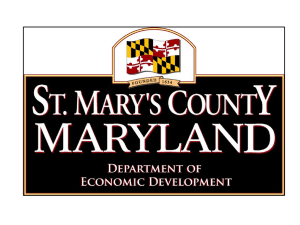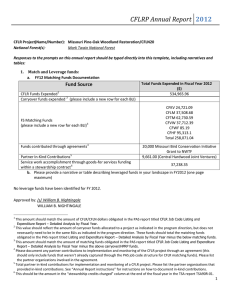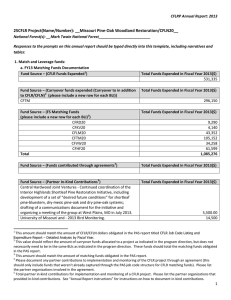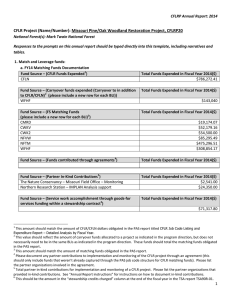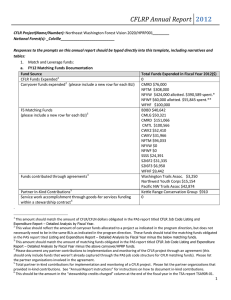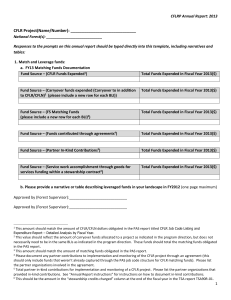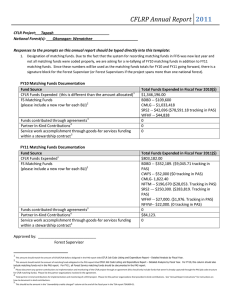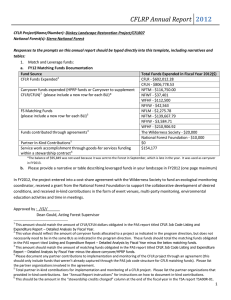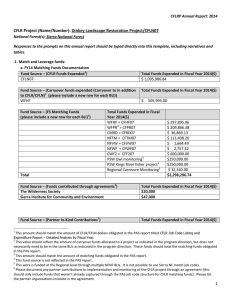CFLRP Work Plan Template Instructions 2012
advertisement
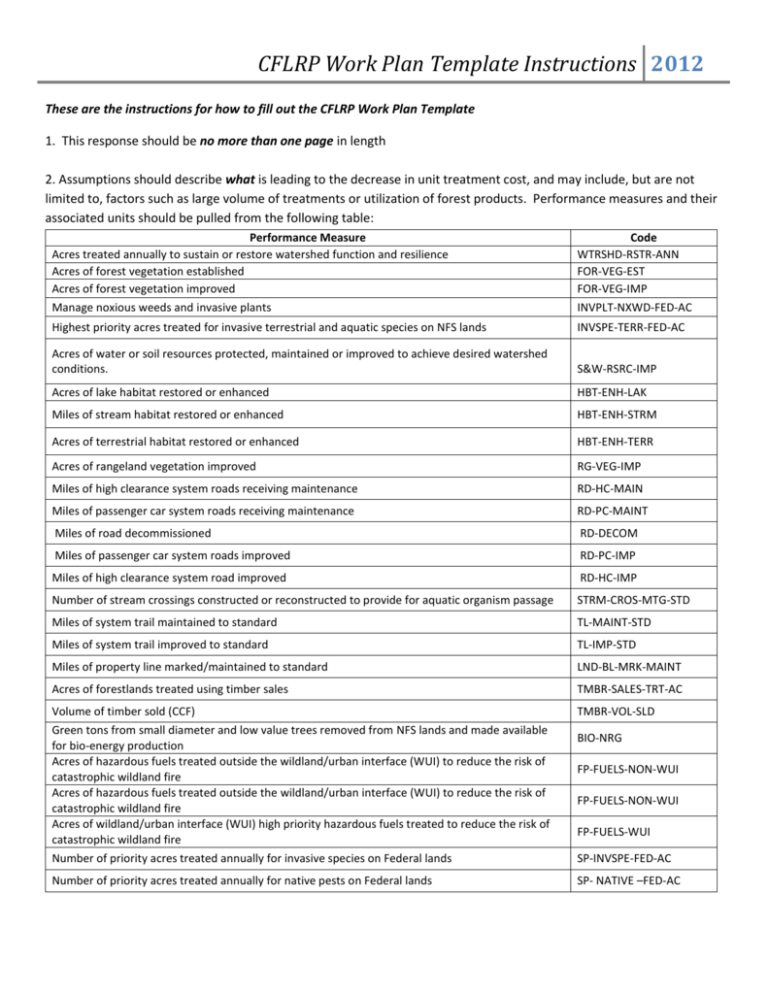
CFLRP Work Plan Template Instructions 2012 These are the instructions for how to fill out the CFLRP Work Plan Template 1. This response should be no more than one page in length 2. Assumptions should describe what is leading to the decrease in unit treatment cost, and may include, but are not limited to, factors such as large volume of treatments or utilization of forest products. Performance measures and their associated units should be pulled from the following table: Performance Measure Acres treated annually to sustain or restore watershed function and resilience Acres of forest vegetation established Acres of forest vegetation improved Manage noxious weeds and invasive plants Code WTRSHD-RSTR-ANN FOR-VEG-EST FOR-VEG-IMP INVPLT-NXWD-FED-AC Highest priority acres treated for invasive terrestrial and aquatic species on NFS lands INVSPE-TERR-FED-AC Acres of water or soil resources protected, maintained or improved to achieve desired watershed conditions. S&W-RSRC-IMP Acres of lake habitat restored or enhanced HBT-ENH-LAK Miles of stream habitat restored or enhanced HBT-ENH-STRM Acres of terrestrial habitat restored or enhanced HBT-ENH-TERR Acres of rangeland vegetation improved RG-VEG-IMP Miles of high clearance system roads receiving maintenance RD-HC-MAIN Miles of passenger car system roads receiving maintenance RD-PC-MAINT Miles of road decommissioned RD-DECOM Miles of passenger car system roads improved RD-PC-IMP Miles of high clearance system road improved RD-HC-IMP Number of stream crossings constructed or reconstructed to provide for aquatic organism passage STRM-CROS-MTG-STD Miles of system trail maintained to standard TL-MAINT-STD Miles of system trail improved to standard TL-IMP-STD Miles of property line marked/maintained to standard LND-BL-MRK-MAINT Acres of forestlands treated using timber sales TMBR-SALES-TRT-AC Volume of timber sold (CCF) TMBR-VOL-SLD Green tons from small diameter and low value trees removed from NFS lands and made available for bio-energy production Acres of hazardous fuels treated outside the wildland/urban interface (WUI) to reduce the risk of catastrophic wildland fire Acres of hazardous fuels treated outside the wildland/urban interface (WUI) to reduce the risk of catastrophic wildland fire Acres of wildland/urban interface (WUI) high priority hazardous fuels treated to reduce the risk of catastrophic wildland fire BIO-NRG FP-FUELS-NON-WUI FP-FUELS-NON-WUI FP-FUELS-WUI Number of priority acres treated annually for invasive species on Federal lands SP-INVSPE-FED-AC Number of priority acres treated annually for native pests on Federal lands SP- NATIVE –FED-AC CFLRP Work Plan Template Instructions 2012 3. This table should be populated with the type of infrastructure needed to carry out the proposal and the anticipated cost of that infrastructure. These values may include infrastructure like temporary roads, or private investment like infrastructure needed to utilize woody biomass. If the infrastructure will be paid for through private investment, indicated this in the “Funding Source” column. 4. Populate this table with the number of acres projected to be treated in methods that will yield woody biomass and small-diameter trees and the projected number of green tons to be removed per acre. The “total green tons available” should be the product of the number of acres to be treated and the number of green tons to be removed per acre. 5. Values for these tables should be obtained using the TREAT data entry tool provided to each team (forthcoming). Once the data entry sheets have been completed, project groups should contact Krista Gebert, Region 1 Regional Economist, in order to run the tool (kgebert@fs.fed.us). Please use projected CFLR funding for the life of the project as your input for one table, then the anticipated total funds to be spent on NFS lands (CFLR, matching, partner) for the second table. 6. This table should be populated with the amount of non-Federal partner funds (Fund Code CWFS) or in-kind contributions anticipated over the life of the project, their sources (partner organization’s name), and a description how those funds were or will be utilized. 7. Populate this table with your best estimates of temporary roads established to carry out the proposal that will be decommissioned, recognizing that your estimates may differ from roads actually decommissioned due to NEPA considerations, etc.


